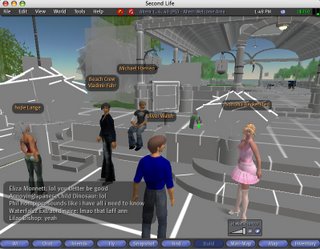Tuesday, July 25, 2006
Explaining the Middle East
Dan Gilbert, a social psychologist at Harvard, had an interesting op-ed piece in the New York Times yesterday. Using the childhood example of punching his brother in the backseat, Gilbert hypothesized about two basic principles of retaliatory behavior. First, in a typical hit-for-tat, the number of hits should be an even number (e.g., you hit me three times, so I hit you three times). Second, as Gilbert puts it, "an even-numbered punch may be no more forceful than the odd-numbered punch that preceded it." However, people often ignore this second principle. He illustrates this point by reporting the results of a study by Shergill et al. (2003) in Science. Titled "Two Eyes for an Eye: The Neuroscience of Force Escalation," in this study twelve participants took turns applying pressure to a partner's finger. They were instructed to apply the same pressure that their partner gave them, but an analysis of the force pressure they produced showed otherwise. Soon the pair would escalate the pressure each member would give the other, apparently believing that they were exerting less force than they actually were (as an aside, I wonder what makes this a "neuroscience" study--I guess it's just a sexy word that Science can't resist). Gilbert applies this finding to explain why Israel (and I guess, Hezbollah) has responded "disproportionately" with its heavy bombing. Of course, real world situations are far more complicated that the controlled conditions of a laboratory, but I appreciate Gilbert's attempt to show the relevance of social psychological thinking to current events.
Wednesday, July 12, 2006
Virtual Life

OK, I confess. I watch "Big Brother" on CBS every summer. And with this summer's "All-Star" edition, I won't be giving up this nasty little habit this year either. I always tell my students that it's the perfect environment for a social psychologist--people trapped together for several days with only miminal contact from the outside world. Occasionally something interesting happens on the show that is unpredictable and not under the control of the producers. My colleagues in behavioral neuroscience get to do this kind of thing with their rats and hamsters all the time. In addition, I like reading the TVClubhouse bulletin board, in which fans of the show discuss every aspect of the social drama going on inside the house. (By the way, I'm rooting for Chicken George, who is from one of my hometowns).
The relatively controlled social environment of shows like this is also what attracts me to new developments in virtual environments and other computer simulations. That's why PhD student Alecks Krotoski's Social Sim blog is right up my alley. Among his activities, Alecks is collecting data about social networks formed in Second Life. What is Second Life? A good answer is posted at the website: "Second Life is a 3-D virtual world entirely built and owned by its residents. Since opening to the public in 2003, it has grown explosively and today is inhabited by 321,127 people from around the globe." I have spent a couple of hours on Second Life, but have severely limited my time on there (after all, I already waste three hours a week watching "BB," right?). It's really the next Big Thing in social interaction, and it's ripe with interesting questions to study as a social scientist. It certainly has the capacity to create experimental situations that could be manipulated with random assignment. Someone just has to figure out how to get informed consent from subjects and, of course, IRB approval.
In the meantime my lab group is starting a program of research in immersive virtual environment technology (IVET). Jim Blascovich at UCSB ran an NSF-sponsored summer training program in IVET for three years at his RecVEB, sowing the seeds for what could be an exciting chapter in social psychology. For some great examples of what can be done with this, check out Jeremy Bailenson's lab at Stanford. I'll be reporting on our own lab's work with IVET as it progresses, or you can check out our lab's web site throughout the next few months.
Monday, July 10, 2006
Sex in Social Neuroscience Sells Too

As one of my earlier posts pointed out, "social neuroscience" is as sexy to some social scientists as Amanda Congdon is to some vlogophiles. Personally, I've been studying the relationship of human social behavior to bodily processes since the days when Martha Quinn was the hottest VJ on MTV. The topic was sexy then, but it was all about using Grass polygraphs in the laboratory to measure cardiac activity, EEG, and facial EMG. Those were heady days in Cacioppo's lab at the University of Iowa, which even included getting our Apple II protocols to run on IBM PCs. I still think the research of that era had more scientific bang for the buck than today's expensive fMRI studies.
With two journals now devoted exclusively to social neuroscience (or "social cognitive neuroscience" as the Lieberman crowd likes to call it!), and still plenty of other prestigious outlets (e.g., Nature Neuroscience, JPSP, Science, etc.) available, can our plucky little field really produce enough good research to fill all those pages? Of course not. But that doesn't stop people from putting out a press release each time they conduct a study with blinking lights and powerful magnets. Some researchers are especially notorious for their press releases, so I was relieved to see that there are bloggers out there ready to give those flashy studies a thorough review (even if the journal's reviewers did not!). A great recent example is the critique by Chris at Mixing Memory of a new study on person perception by Jason Mitchell, Neil Macrae and Mahzarin Banaji in the May issue of Neuron. I have to admit that I have not read the study yet, but this critique makes some excellent points that could apply to other human imaging studies in social psychology as well (a new study from Susan Fiske's lab at Princeton comes to mind!). You should also read the discussion of this study in BRAINETHICS as well. When I get a chance to read the Mitchell et al. study, I'll write an update. This post is simply to express my gratitude for the development of science blogs and the willingness of intelligent bloggers to write such critiques.
Friday, July 7, 2006
Scooter

See that blur there?! That's the newest addition to our family! I have maintained acquariums on and off since I was a teen, but have never successfully bred and raised a fish. Most of the time I can't tell when a fish is pregnant (let alone what sex it is!), and therefore the "fry" are usually eaten up by the time I discover anything happened. Well, this time I was lucky. One of the fry must have been sucked up the filtering tube and was living in the external filter basket where I discovered him on a recent cleaning. He's a little zebrafish (Danio rerio) now living safely in a breeding container that floats at the top of the aquarium. As far as I can tell, it looks like he'll have to be there about a month. There are three possible parents in the tank. None appears ready for parenthood.
Subscribe to:
Posts (Atom)
